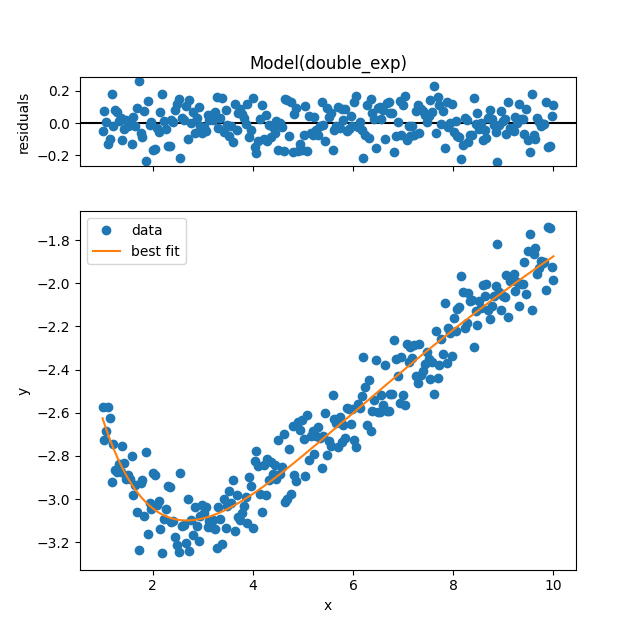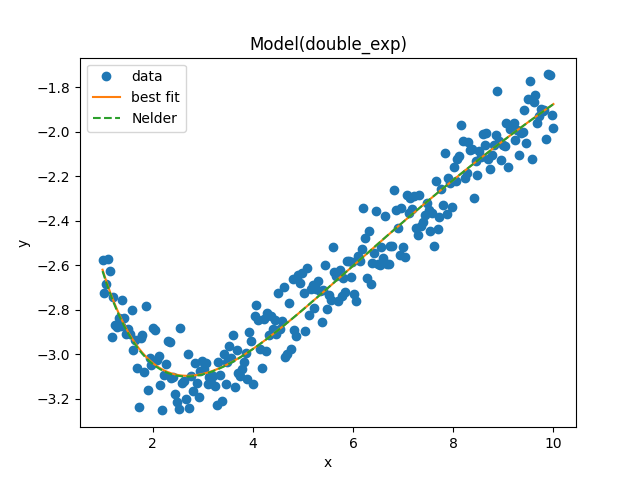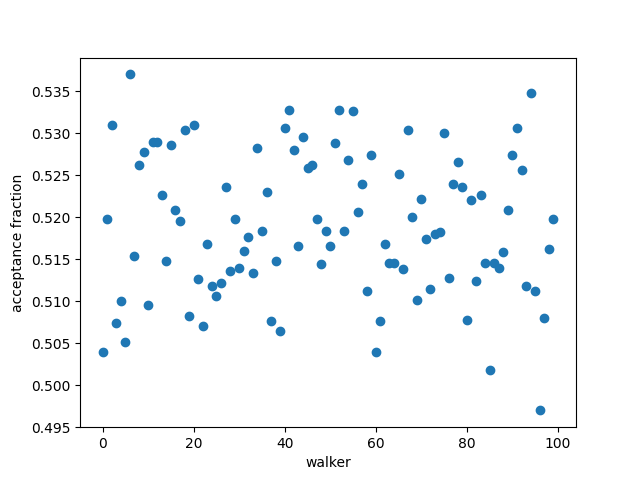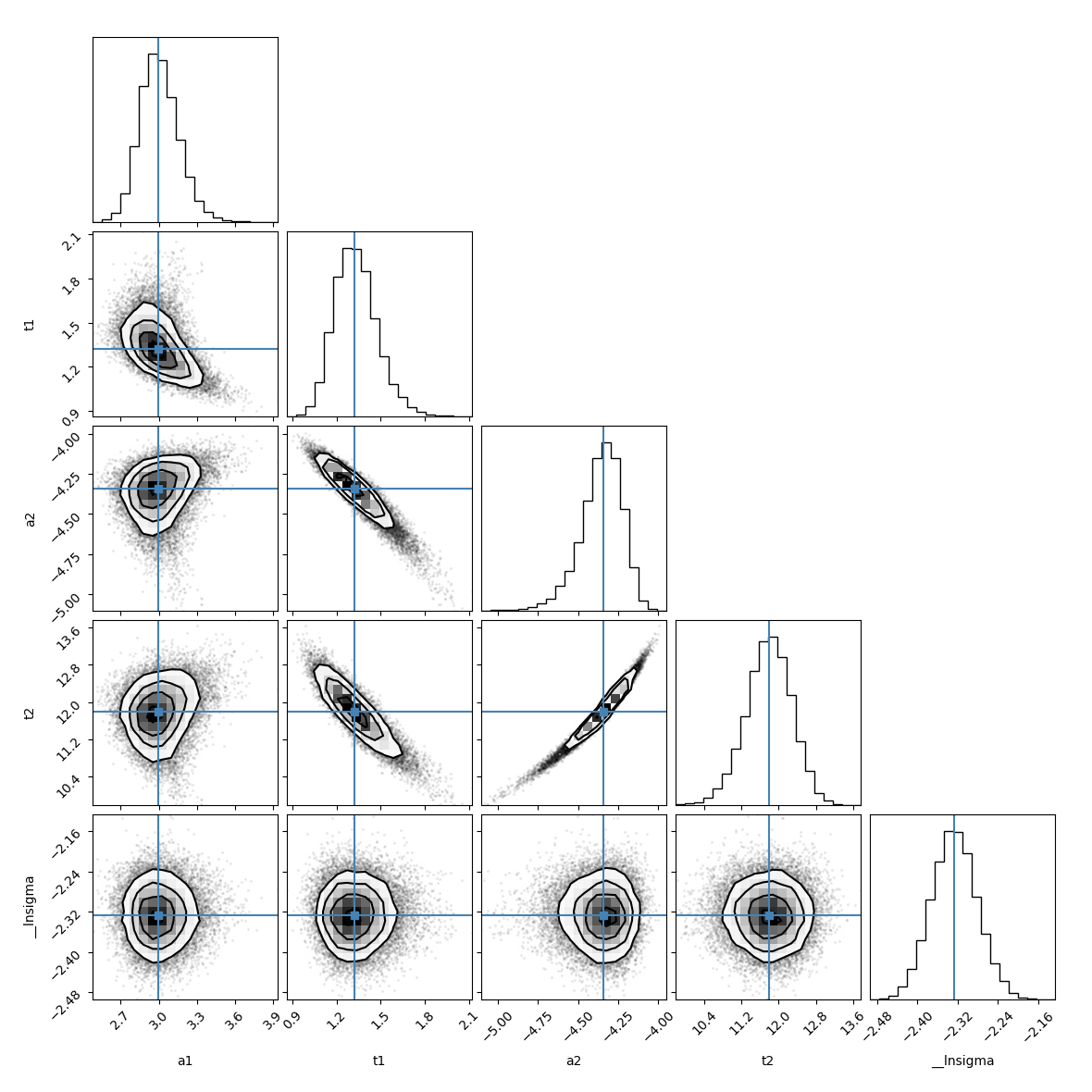Note
Click here to download the full example code
Emcee and the Model Interface¶
import corner
import matplotlib.pyplot as plt
import numpy as np
import lmfit
Set up a double-exponential function and create a Model
Generate some fake data from the model with added noise
truths = (3.0, 2.0, -5.0, 10.0)
x = np.linspace(1, 10, 250)
np.random.seed(0)
y = double_exp(x, *truths)+0.1*np.random.randn(x.size)
Create model parameters and give them initial values
p = model.make_params(a1=4, t1=3, a2=4, t2=3)
Fit the model using a traditional minimizer, and show the output:

Out:
/Users/Newville/Codes/lmfit-py/examples/example_emcee_Model_interface.py:16: RuntimeWarning: overflow encountered in exp
return a1*np.exp(-x/t1) + a2*np.exp(-(x-0.1) / t2)
/Users/Newville/Codes/lmfit-py/examples/example_emcee_Model_interface.py:16: RuntimeWarning: overflow encountered in multiply
return a1*np.exp(-x/t1) + a2*np.exp(-(x-0.1) / t2)
/Users/Newville/Codes/lmfit-py/lmfit/minimizer.py:173: RuntimeWarning: overflow encountered in multiply
return (r*r).sum()
[[Fit Statistics]]
# fitting method = Nelder-Mead
# function evals = 609
# data points = 250
# variables = 4
chi-square = 2.33333982
reduced chi-square = 0.00948512
Akaike info crit = -1160.54007
Bayesian info crit = -1146.45423
[[Variables]]
a1: 2.98623689 +/- 0.15010519 (5.03%) (init = 4)
t1: 1.30993186 +/- 0.13449652 (10.27%) (init = 3)
a2: -4.33525597 +/- 0.11765819 (2.71%) (init = 4)
t2: 11.8099125 +/- 0.47172590 (3.99%) (init = 3)
[[Correlations]] (unreported correlations are < 0.100)
C(a2, t2) = 0.988
C(t1, a2) = -0.928
C(t1, t2) = -0.885
C(a1, t1) = -0.609
C(a1, a2) = 0.297
C(a1, t2) = 0.232
(<Figure size 640x640 with 2 Axes>, GridSpec(2, 1, height_ratios=[1, 4]))
Calculate parameter covariance using emcee:
start the walkers out at the best-fit values
set is_weighted to False to estimate the noise weights
set some sensible priors on the uncertainty to keep the MCMC in check
run the MCMC algorithm and show the results:
result_emcee = model.fit(data=y, x=x, params=emcee_params, method='emcee',
nan_policy='omit', fit_kws=emcee_kws)
lmfit.report_fit(result_emcee)
ax = plt.plot(x, model.eval(params=result.params, x=x), label='Nelder', zorder=100)
result_emcee.plot_fit(ax=ax, data_kws=dict(color='gray', markersize=2))
plt.show()

Out:
The chain is shorter than 50 times the integrated autocorrelation time for 5 parameter(s). Use this estimate with caution and run a longer chain!
N/50 = 20;
tau: [42.86236444 45.34591993 45.49852485 45.00527243 38.05671107]
[[Fit Statistics]]
# fitting method = emcee
# function evals = 100000
# data points = 250
# variables = 5
chi-square = 245.135584
reduced chi-square = 1.00055340
Akaike info crit = 5.08763609
Bayesian info crit = 22.6949407
[[Variables]]
a1: 2.99729292 +/- 0.14788788 (4.93%) (init = 2.986237)
t1: 1.31860631 +/- 0.14157651 (10.74%) (init = 1.309932)
a2: -4.34320377 +/- 0.12457281 (2.87%) (init = -4.335256)
t2: 11.7995440 +/- 0.49140460 (4.16%) (init = 11.80991)
__lnsigma: -2.32707117 +/- 0.04573634 (1.97%) (init = -2.302585)
[[Correlations]] (unreported correlations are < 0.100)
C(a2, t2) = 0.982
C(t1, a2) = -0.933
C(t1, t2) = -0.888
C(a1, t1) = -0.567
C(a1, a2) = 0.271
C(a1, t2) = 0.230
/Users/Newville/Codes/lmfit-py/examples/example_emcee_Model_interface.py:60: UserWarning: Matplotlib is currently using agg, which is a non-GUI backend, so cannot show the figure.
plt.show()
check the acceptance fraction to see whether emcee performed well
plt.plot(result_emcee.acceptance_fraction)
plt.xlabel('walker')
plt.ylabel('acceptance fraction')
plt.show()

Out:
/Users/Newville/Codes/lmfit-py/examples/example_emcee_Model_interface.py:67: UserWarning: Matplotlib is currently using agg, which is a non-GUI backend, so cannot show the figure.
plt.show()
try to compute the autocorrelation time
if hasattr(result_emcee, "acor"):
print("Autocorrelation time for the parameters:")
print("----------------------------------------")
for i, p in enumerate(result.params):
print(p, result.acor[i])
Plot the parameter covariances returned by emcee using corner
emcee_corner = corner.corner(result_emcee.flatchain, labels=result_emcee.var_names,
truths=list(result_emcee.params.valuesdict().values()))

print("\nmedian of posterior probability distribution")
print('--------------------------------------------')
lmfit.report_fit(result_emcee.params)
# find the maximum likelihood solution
highest_prob = np.argmax(result_emcee.lnprob)
hp_loc = np.unravel_index(highest_prob, result_emcee.lnprob.shape)
mle_soln = result_emcee.chain[hp_loc]
print("\nMaximum likelihood Estimation")
print('-----------------------------')
for ix, param in enumerate(emcee_params):
print(param + ': ' + str(mle_soln[ix]))
quantiles = np.percentile(result_emcee.flatchain['t1'], [2.28, 15.9, 50, 84.2, 97.7])
print("\n\n1 sigma spread", 0.5 * (quantiles[3] - quantiles[1]))
print("2 sigma spread", 0.5 * (quantiles[4] - quantiles[0]))
Out:
median of posterior probability distribution
--------------------------------------------
[[Variables]]
a1: 2.99729292 +/- 0.14788788 (4.93%) (init = 2.986237)
t1: 1.31860631 +/- 0.14157651 (10.74%) (init = 1.309932)
a2: -4.34320377 +/- 0.12457281 (2.87%) (init = -4.335256)
t2: 11.7995440 +/- 0.49140460 (4.16%) (init = 11.80991)
__lnsigma: -2.32707117 +/- 0.04573634 (1.97%) (init = -2.302585)
[[Correlations]] (unreported correlations are < 0.100)
C(a2, t2) = 0.982
C(t1, a2) = -0.933
C(t1, t2) = -0.888
C(a1, t1) = -0.567
C(a1, a2) = 0.271
C(a1, t2) = 0.230
Maximum likelihood Estimation
-----------------------------
a1: 2.9516079567371394
t1: 1.320921622273492
a2: -4.333103563716343
t2: 11.84652506057183
__lnsigma: -2.3328583631734823
1 sigma spread 0.14166142736065634
2 sigma spread 0.28026477066939837
Total running time of the script: ( 0 minutes 11.075 seconds)